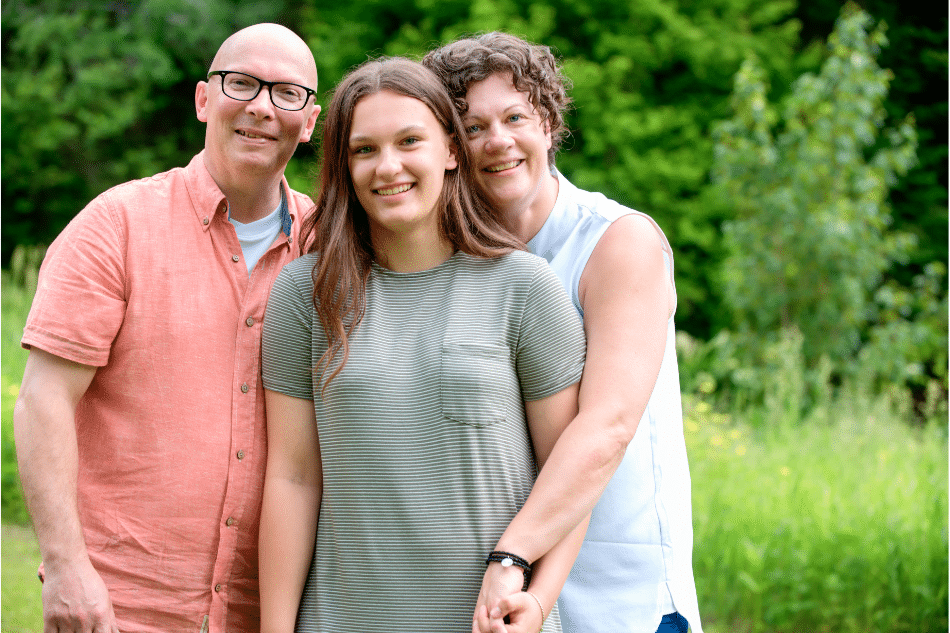When to Get Help for a Nervous Breakdown:
Teen Crisis Signs and Resources

It’s common for teens to go through emotional ups and downs, but how can a parent tell when fluctuations in mental states are more than just a phase?
Signs professional help is needed for teen well-being may include withdrawal from friends, disrupted sleep, and sudden mood swings. If left unaddressed, these symptoms could develop into something even more serious, like a nervous breakdown. While a nervous breakdown isn’t a formal diagnosis, it is a term used to describe a mental health crisis that requires immediate attention.
Whether you’re a teen or a caregiver, understanding when to seek help for mental health is essential. You don’t have to cope on your own. A mental health professional can ensure that you receive timely care, compassionate treatment, and real healing.
This guide can also help, as it explores:
- Signs of a teen nervous breakdown
- How to recognize critical mental health moments
- Tips for youth crisis management
- Crisis response programs and treatment for teens
- How Mission Prep can help with therapy for teen breakdowns

Signs of a Teen Nervous Breakdown
Recognizing a nervous breakdown can be challenging, especially when typical hormone changes, identity exploration, and social pressures can already contribute to emotional ups and downs.
However, a nervous breakdown, or what clinicians might call a “psychological crisis,” involves a tipping point where a teen’s ability to function, cope, or even communicate effectively becomes severely disrupted.
Mental health crises rarely resolve on their own. But identifying the signs of a teen nervous breakdown can ensure that they receive early intervention, providing the best chance at successful recovery and outcomes for the future.
The following are some of the warning signs that may indicate a teen is approaching or experiencing a mental health breakdown:
Withdrawal:
Research indicates a link between social withdrawal and depressive symptoms.¹ Therefore, if a teen is pulling away from friends, family, or activities they used to enjoy, this may indicate that something is happening below the surface.
Emotional Outbursts:
A mental health crisis may involve sudden emotional volatility, including outbursts of anger, prolonged crying, or intense irritability that doesn’t seem to fit the situation.²
Cognitive Overload:
If a teen is struggling with their mental health, they may have trouble concentrating, be forgetful, or experience decision paralysis, especially in school or social settings.³
Disturbed Sleep Patterns:
Either sleeping far too much or not at all can often be an early sign of distress.⁴
Somatic Symptoms:
Mental health issues can often disguise themselves as physical issues, such as chronic headaches, stomach pains, chest tightness, or fatigue, even in the absence of a physical illness.⁵
Out of Character Behaviors:
Statements or actions suggesting hopelessness, panic, or a loss of control could show up in the lead-up to a nervous breakdown.⁶
If a teen experiences a couple of these issues, they may be reaching a point of an acute mental health episode. Early intervention for youth is key at this stage, and professional support is available and recommended.
Recognizing Critical Mental Health Moments
There’s a difference between emotional growing pains and moments of genuine mental health crisis. Recognizing this difference is often what prevents a difficult week from turning into a long-term breakdown. However, loved ones may not know how to tell the difference between critical mental health moments and typical behaviors.
A critical mental health moment is any point where a teen’s thoughts, behaviors, or emotional state suggest they can no longer cope on their own. But these moments may not always look extreme. Sometimes, they may appear as subtle behavioral shifts in response to triggers. For instance, you may notice:
- A sudden drop in grades
- Someone who is typically social pulling away from family and friends
- A typically even-tempered young person becoming explosively angry over small things
- Statements like “I don’t care anymore,” or “Nothing matters”
In other words, if a teen starts to act out of character, it may be time to take notice. You don’t need to wait for a crisis to consider getting help for nervous breakdown teens. In fact, early intervention is one of the most powerful tools we have.
Parents, and even teens themselves, can take the first step by reaching out to a therapist or school counselor, connecting with youth crisis management resources, or researching adolescent therapy options.
Youth Crisis Management Tips
When a teen is experiencing a psychological crisis, it can be hard to know what to do. While they may lash out, withdraw completely, or mask distress with humor or defiance, beneath these behaviors is often a nervous system under siege. Even though they may need and want your help, they might not know how to ask for it. However, you can still be a much-needed source of support for them during their time of need.
When supporting a teen through a nervous breakdown, try to:
- Stay calm: Your grounding presence can be powerful, as it can help a teen feel anchored and safe. It could also model healthy emotion regulation, allowing them to adapt their ability to cope in the moment.
- Listen actively: Let them know that you’re ready to listen without trying to fix things.
- Speak slowly: Avoid pushing them to explain things they may not understand. While they may seem like they’re “shutting down,” they may actually be internally overloaded.
- Give them resources: Emergency support for youth includes hotlines such as the 988 Suicide hotline and the NAMI Teen and Young Adult Helpline.
- Suggest professional support: Gently introducing the idea of how to talk to a therapist can help normalize professional support. You could also suggest helping them find someone who could help.
- Set healthy routines: In the long run, sleep and nutrition routines can help a teen find stability and safety, especially when coping with everyday challenges.⁷
Each of these steps can help a teen feel supported and calmer during a crisis moment. However, if you’re concerned about their immediate safety, it’s important to consider teen crisis intervention resources. For instance, calling 911 or bringing them to your local emergency department.
Treatment Options for Teens in Psychological Distress
When a teen is in the middle of a psychological crisis, the right therapeutic approach can offer a path back to safety, stability, and hope. These aren’t one-size-fits-all solutions but rather, tailored, research-supported methods that speak directly to the needs of developing minds.
Adolescent therapy options for crisis recovery include the following options.
1. Cognitive Behavioral Therapy (CBT)
CBT is one of the most widely used approaches for teens in crisis. Whether they’re facing anxiety, depression, or trauma-related symptoms, CBT equips teens with concrete strategies for managing overwhelming emotions and behaviors. For instance, it can help teens pinpoint inaccuracies in thinking and how to challenge these to reduce distress.⁸
2. Dialectical Behavior Therapy (DBT)
DBT is often used for teens struggling with intense emotions, urges to self-harm, or suicidality.⁹ It teaches key skills in four areas, including emotional regulation, distress tolerance, interpersonal effectiveness, and mindfulness. Many crisis response programs for teens include DBT in their treatment plans, especially when they struggle to manage their emotions.
3. Trauma-Focused Therapy
For teens who’ve experienced acute or chronic trauma, therapies like TF-CBT (Trauma-Focused CBT) or EMDR (Eye Movement Desensitization and Reprocessing) may be appropriate.¹⁰ These approaches help teens process traumatic experiences safely, reducing distress and improving day-to-day functioning.
4. Family Therapy
Family dynamics sometimes play a role in mental health crises. Family therapy can improve communication, repair trust, and ensure the home environment supports healing.¹¹ This kind of therapy is a key part of residential treatment for teens and many outpatient programs.
5. Mindfulness and Somatic Practices
Therapies that incorporate body awareness, such as mindfulness training, breathwork, or grounding exercises, can support nervous system regulation. These are especially useful in calming the physiological symptoms of panic, stress, or dissociation during and after a teen breakdown.¹²
6. Medication Management
While not always necessary, some teens benefit from short- or long-term psychiatric support. Medication can help regulate mood, reduce intrusive thoughts, or stabilize symptoms that prevent engagement in therapy.
Crisis Response Programs for Teens
Each of the previously discussed treatment options for teens in psychological distress can be incorporated into a crisis response program. Crisis response programs for teens are designed to offer stability, safety, and a plan for long-term healing.
The choice of intervention paths will depend on a teen’s level of need, but common options include:
Outpatient Therapy
Outpatient treatment typically involves weekly sessions with a licensed therapist. These sessions provide a safe space to process stressors, develop emotional regulation skills, and rebuild trust. It’s a particularly effective form of therapy for teen breakdown as it supports emotional growth while keeping teens connected to their home and school life.
Intensive Outpatient Programs (IOP)
If standard therapy isn’t enough, IOP offers a higher level of support, often including several therapy sessions per week, group support, and family education. These programs are ideal for teens who are struggling but still able to function at home with structure. They often serve as a bridge between outpatient care and residential treatment.
Residential Treatment Centers
In severe cases, especially when safety is a concern, residential treatment for teens may be recommended. These live-in programs provide 24/7 care, psychiatric support, and structured therapeutic environments. While the idea of residential treatment may feel overwhelming to families, it often offers a turning point for teens who need a full reset to stabilize.
Crisis Stabilization Units
These short-term inpatient facilities focus on immediate safety and mental stabilization. Typically, teens stay for a few days under close supervision, receiving medication management if needed, and a follow-up plan for continued care. Crisis stabilization is often used during acute psychiatric emergencies.
School and Community-Based Programs
Many communities offer early intervention for youth through school counselors, mobile crisis teams, or youth-specific mental health initiatives. These can be especially helpful for families who aren’t sure where to begin or who need guidance navigating the system.
Each of these crisis response options works toward keeping teens safe while helping them heal. The right choice will depend on the intensity of the symptoms, the risks at hand, and the teen’s willingness to engage.

Mission Prep: Professional Therapy for Teen Breakdowns
At Mission Prep, we specialize in therapy for teen breakdowns that is tailored to the individual needs of each young person and their family. Our team offers comprehensive emotional and mental health assessments, individualized treatment planning, and experienced therapists trained in adolescent crisis care.
If your teen is showing signs that professional help is needed, our team is here to support them every step of the way. If you’re unsure where to begin, start by reaching out to Mission Prep today.
References
- Malhotra, A., Mars, J. A., & Baker, J. (2025). Group therapy. In StatPearls. StatPearls Publishing. https://bmcpsychiatry.biomedcentral.com/articles/10.1186/s12888-025-06792-6
- Carlson, G. A., Singh, M. K., Amaya-Jackson, L., Benton, T. D., Althoff, R. R., Bellonci, C., Bostic, J. Q., Chua, J. D., Findling, R. L., Galanter, C. A., Gerson, R. S., Sorter, M. T., Stringaris, A., Waxmonsky, J. G., & McClellan, J. M. (2023). Narrative review: Impairing emotional outbursts—What they are and what we should do about them. Journal of the American Academy of Child and Adolescent Psychiatry, 62(2), 135–150. https://www.sciencedirect.com/science/article/pii/S089085672200123X
- Burns, R. D., Pfledderer, C. D., & Fu, Y. (2021). Adolescent health behaviors and difficulty concentrating, remembering, and making decisions. American Journal of Lifestyle Medicine, 15(6), 664–672. https://pmc.ncbi.nlm.nih.gov/articles/PMC8669897/
- Åslund, L., Andreasson, A., Lekander, M., Henje, E., & Dennhag, I. (2023). Disturbed sleep and patterns of psychiatric symptoms and function in a school-based sample of adolescents. Clinical Child Psychology and Psychiatry, 28(4), 1524–1535. https://pmc.ncbi.nlm.nih.gov/articles/PMC10540489/
- Bohman, H., Låftman, S. B., Cleland, N., Lundberg, M., Päären, A., & Jonsson, U. (2018). Somatic symptoms in adolescence as a predictor of severe mental illness in adulthood: A long-term community-based follow-up study. Child and Adolescent Psychiatry and Mental Health, 12(1), 42. https://pmc.ncbi.nlm.nih.gov/articles/PMC6090675/
- Cackovic, C., Nazir, S., & Marwaha, R. (2025). Panic disorder. In StatPearls. StatPearls Publishing. https://www.ncbi.nlm.nih.gov/books/NBK430973/
- Arlinghaus, K. R., & Johnston, C. A. (2019). The importance of creating habits and routine. American Journal of Lifestyle Medicine, 13(2), 142–144. https://pmc.ncbi.nlm.nih.gov/articles/PMC6378489/
- Halder, S., & Mahato, A. K. (2019). Cognitive behavior therapy for children and adolescents: Challenges and gaps in practice. Indian Journal of Psychological Medicine, 41(3), 279–283. https://pmc.ncbi.nlm.nih.gov/articles/PMC6532387/
- Kothgassner, O. D., Goreis, A., Robinson, K., Huscsava, M. M., Schmahl, C., & Plener, P. L. (2021). Efficacy of dialectical behavior therapy for adolescent self-harm and suicidal ideation: A systematic review and meta-analysis. Psychological Medicine, 51(7), 1057–1067. https://pmc.ncbi.nlm.nih.gov/articles/PMC8188531/
- de Arellano, M. A. R., Lyman, D. R., Jobe-Shields, L., George, P., Dougherty, R. H., Daniels, A. S., Ghose, S. S., Huang, L., & Delphin-Rittmon, M. E. (2014). Trauma-focused cognitive-behavioral therapy for children and adolescents: Assessing the evidence. Psychiatric Services, 65(5), 591–602. https://pmc.ncbi.nlm.nih.gov/articles/PMC4396183/
- Varghese, M., Kirpekar, V., & Loganathan, S. (2020). Family interventions: Basic principles and techniques. Indian Journal of Psychiatry, 62(Suppl 2), S192–S200. https://pmc.ncbi.nlm.nih.gov/articles/PMC7001353/
- Pérez-Peña, M., Notermans, J., Desmedt, O., Van der Gucht, K., & Philippot, P. (2022). Mindfulness-based interventions and body awareness. Brain Sciences, 12(2), 285. https://pmc.ncbi.nlm.nih.gov/articles/PMC8869993/
